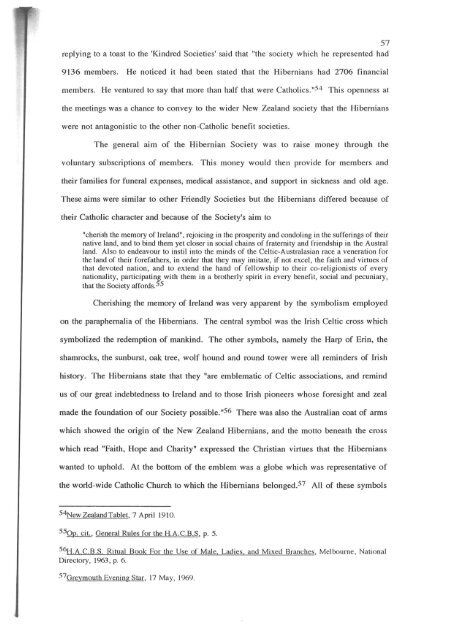TRANSPLANTED IRISH INSTITUTIONS - University of Canterbury
TRANSPLANTED IRISH INSTITUTIONS - University of Canterbury
TRANSPLANTED IRISH INSTITUTIONS - University of Canterbury
Create successful ePaper yourself
Turn your PDF publications into a flip-book with our unique Google optimized e-Paper software.
57<br />
replying to a toast to the 'Kindred Societies' said that "the society which he represented had<br />
9136 members. He noticed it had been stated that the Hibernians had 2706 financial<br />
members. He ventured to say that more than half that were Catholics. "54 This openness at<br />
the meetings was a chance to convey to the wider New Zealand society that the Hibernians<br />
were not antagonistic to the other non-Catholic benefit societies.<br />
The general aim <strong>of</strong> the Hibernian Society was to raIse money through the<br />
voluntary subscriptions <strong>of</strong> members. This money would then provide for members and<br />
their families for funeral expenses, medical assistance, and support in sickness and old age.<br />
These aims were similar to other Friendly Societies but the Hibernians differed because <strong>of</strong><br />
their Catholic character and because <strong>of</strong> the Society's aim to<br />
"cherish the memory <strong>of</strong> Ireland", rejoicing in the prosperity and condoling in the sufferings <strong>of</strong> their<br />
native land, and to bind them yet closer in social chains <strong>of</strong> fraternity and friendship in the Austral<br />
land. Also to endeavour to instil into the minds <strong>of</strong> the Celtic-Australasian race a veneration for<br />
the land <strong>of</strong> their forefathers, in order that they may imitate, if not excel, the faith and virtues <strong>of</strong><br />
that devoted nation, and to extend the hand <strong>of</strong> fellowship to their co-religionists <strong>of</strong> every<br />
nationality, participating with them in a brotherly spirit in every benefit, social and pecuniary,<br />
that the Society affords. 55<br />
Cherishing the memory <strong>of</strong> Ireland was very apparent by the symbolism employed<br />
on the paraphernalia <strong>of</strong> the Hibernians. The central symbol was the Irish Celtic cross which<br />
symbolized the redemption <strong>of</strong> mankind. The other symbols, namely the Harp <strong>of</strong> Erin, the<br />
shamrocks, the sunburst, oak tree, wolf hound and round tower were all reminders <strong>of</strong> Irish<br />
history. The Hibernians state that they "are emblematic <strong>of</strong> Celtic associations, and remind<br />
us <strong>of</strong> our great indebtedness to Ireland and to those Irish pioneers whose foresight and zeal<br />
made the foundation <strong>of</strong> our Society possible. "56 There was also the Australian coat <strong>of</strong> arms<br />
which showed the origin <strong>of</strong> the New Zealand Hibernians, and the motto beneath the cross<br />
which read "Faith, Hope and Charity" expressed the Christian virtues that the Hibernians<br />
wanted to uphold. At the bottom <strong>of</strong> the emblem was a globe which was representative <strong>of</strong><br />
the world-wide Catholic Church to which the Hibernians belonged. 57 All <strong>of</strong> these symbols<br />
54NewZealandTablet, 7 April 1910.<br />
550p. cit., General Rules for the H.A.C.B.S, p. 5.<br />
56H.A.C.B.S. Ritual Book For the Use <strong>of</strong> Male, Ladies, and Mixed Branches, Melbourne, National<br />
Directory, 1963, p. 6.<br />
5 7 Greymouth Evening Star, 17 May, 1969.
















